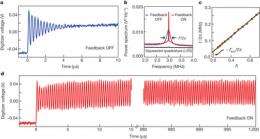October 4, 2012 report
Researchers devise a means to 'gently' measure qubit without destroying superposition

(Phys.org)—As understood in the field of quantum mechanics, objects are able to exist in more than one state at a time, a property known as superposition. Measuring such states is a challenge however, as doing so causes the superposition property to be destroyed, at least according to classical theory. Now, physicists working at the University of California have found a way to cheat the system, so to speak. They have, as they describe in their paper published in the journal Nature, found a way to take a quick peek at the oscillation of a qubit, without destroying its superposition property.
The whole idea behind superposition was famously explained by Erwin Schrödinger, who suggested it could be thought of as a cat in a box that also contained a radioactive atom . The decay of the atom could not be known without opening the box and checking—an act that would change its state. From a perspective outside the box, the cat was apparently both dead and alive at the same time. In this new work, the researchers suggest that only partially opening the box gives them some insight into the box's inner conditions without disturbing its contents.
To make that happen, the team employed a feedback control mechanism whereby a superconducting qubit was coupled to a microwave cavity. It was then pushed into a superposition state by cycling its state back and forth between 0 and 1, repeatedly hitting all possible mixtures. Once there, they measured its oscillation frequency. This measurement was too weak to destroy the oscillation but strong enough to cause slight change. Using the measurement taken, the team very quickly calculated, and then created, an exact opposite charge which they injected back into the system, causing the oscillation to return to its former frequency: they had managed to measure a tiny part of the system without destroying the superposition state, a feat never before achieved in the lab.
In order to carry out this experiment, the team had to first develop an amplifier that would allow them to inject the charge back into the system without making other changes—no small thing. This development led to the first instance of a qubit being measured, if only partially, without changing its state. The researchers suggest their technique might be used as a means of error control in a quantum system, i.e. computer, by allowing qubits to exist in a superposition state for longer periods of time.
More information: Stabilizing Rabi oscillations in a superconducting qubit using quantum feedback, Nature, 490, 77–80 (04 October 2012) doi:10.1038/nature11505
Abstract
The act of measurement bridges the quantum and classical worlds by projecting a superposition of possible states into a single (probabilistic) outcome. The timescale of this 'instantaneous' process can be stretched using weak measurements, such that it takes the form of a gradual random walk towards a final state. Remarkably, the interim measurement record is sufficient to continuously track and steer the quantum state using feedback. Here we implement quantum feedback control in a solid-state system, namely a superconducting quantum bit (qubit) coupled to a microwave cavity. A weak measurement of the qubit is implemented by probing the cavity with microwave photons, maintaining its average occupation at less than one photon. These photons are then directed to a high-bandwidth, quantum-noise-limited amplifier, which allows real-time monitoring of the state of the cavity (and, hence, that of the qubit) with high fidelity. We demonstrate quantum feedback control by inhibiting the decay of Rabi oscillations, allowing them to persist indefinitely. Such an ability permits the active suppression of decoherence and enables a method of quantum error correction based on weak continuous measurements. Other applications include quantum state stabilization, entanglement generation using measurement, state purification and adaptive measurements.
Journal information: Nature
© 2012 Phys.org


















